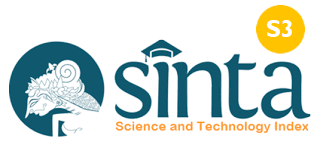The Relationship Between Language Learning Strategy And Reading Comprehension Students Of Sman 1 Unaaha
Abstract
The following objectives of this study are (1) to investigate whether between language learning strategy and reading comprehension has a significance correlation or not; (2) to examine how far learning strategy affects students reading comprehension (3) to examine what learning strategy and reading comprehension are mostly employed by the students of SMA 1 Unaaha, (4) to examine of the sixth aspect of language learning strategy which aspect correlate more strongly to reading comprehension. The result in the first hypotesis shows that there is a significance correlation language learning strategy to reading comprehension. The second hypothesis the contribution of language learning strategy to reading comprehension is only 14.8% and 85.2% is explained by the other factor that is not include in the model. The result of the third hypothesis indicates that most of English Department students in SMAN 1 Unaaha Employed metacognitive strategy, cognitive and memory strategy very often in learning English as a foreign language than the other strategy; affective, social and compensation strategy. The last hypothesis shows that the stronger correlation between the six aspects of learning strategy to the levels of reading comprehension lie on the correlation between metacognitive to literal comprehension, metacognitive to interpretive comprehension and the last is the correlation between cognitive to literal comprehension.
References
D.H. Brown, Strategies for Success: A Practical Guide to Learning English, (2002), New York: Addison Wesley, Longman, Inc.
Ehrman, M., & Oxford, R. (2003). Adult language learning styles and strategies in an intensive training setting. The Modern Language Journal(74), 311-327.
Ehrman, M., & Oxford, R. (1995). Cognition plus: correlates of language learning success. The Modern Language Journal(79), 67-89.
Ehrman and Oxford (2003) conducted a study about the relationship between gender and strategy used by applying a mixed method design.
Fahimeh Marefat (2009) conducted a study related to the relationship between out-of-class language learning strategy and reading comprehension ability.
Gove., M. (2007). Clarifying teachers’ beliefs about reading. The Reading Teacher(37), 261–267.
Grabe, W., & Stoller, F. L. (2002). Teaching and researching reading. britain: A Pearson Education Company.
Grease, A. F. (2007). Model comprehension strategy lesson plan for I could not keep silent: The life of Rachel Carson.
Hamed, & Reza. (2012). Critical Thinking: A Reading Strategy in Developing English.
Hosseini, E., Khodaei, F. B., Sarfallah, S., & Dolatabadi, H. R. (2012). Exploring the relationship between Critical Thinking, Reading Comprehension and Reading Skill in English University students. World Applied Sciences Journal, 17(10), 1356-1364.
Hossein Tavakoli (2014) investigated the Effectiveness of metacognitive strategy awareness in reading comprehension
Küpper, & chamot. (2005). Learning strategy applications with students of English as a second language. TESOL Quarterly (19 (3)), 557-584.
Kricjie, & Morgan. (1970). Determining Sample Size for Research Activities. 30, 607-610.
McNeil, J. D. (2002). Reading Comprehension: New Directions for Classroom Practice, third ed: Harper Collins Publishers.
N. Fewel, Language learning strategies and English language proficiency: An investigation of Japanese EFL University students, TESOL Journal, 2(2010), 159-174.
Nakayanti, A. R. (2018). Pelaksanaan Pendidikan Budi Pekerti Di SD Negeri 8 Sumerta Kecamatan Denpasar Timur. Cetta: Jurnal Ilmu Pendidikan, 1(1), 16-25.
Oxford, R., & Crookall, D. (2003). Research on language learning strategies: methods, findings, and instructional issues. The Modern Language Journal(73 (4)), 404-419.
Oxford, R., & Crookall, D. (2009). Learning strategies: You can take it with you:Variables afecting choice of language learning strategies by university students. The Modern Language Journal (73 (3)), 291-300.
Panel, N. R. (2000). teaching children to read: An evidence-based assessment of the scientific research literature on reading and its implications for reading instruction. Washington, DC: National Institute of Child Health and Human Development.
Pang, S, E., Muaka, A., Bernhardt, E. B., & Kamil, M. L. (2003). Teaching reading. Geneva: The International Academy of Education.
Sarah, E. (2009). Knowledge for teaching reading comprehension mapping the terrain. Unpublished doctoral dissertation, the University of Michigan: U.S.A.
Sudarsana, I. K. (2018). Optimalisasi Penggunaan Teknologi Dalam Implementasi Kurikulum Di Sekolah (Persepektif Teori Konstruktivisme). Cetta: Jurnal Ilmu Pendidikan, 1(1), 8-15.
T. Hedge, Teaching and Learning in the Language Classroom, (2008), Oxford University Press
Downloads
Published
How to Cite
Issue
Section
License
An author who publishes in the Cetta : Jurnal Ilmu Pendidikan agrees to the following terms:
- Author retains the copyright and grants the journal the right of first publication of the work simultaneously licensed under the Creative Commons Attribution-ShareAlike 4.0 License that allows others to share the work with an acknowledgement of the work's authorship and initial publication in this journal
- Author is able to enter into separate, additional contractual arrangements for the non-exclusive distribution of the journal's published version of the work (e.g., post it to an institutional repository or publish it in a book) with the acknowledgement of its initial publication in this journal.
- Author is permitted and encouraged to post his/her work online (e.g., in institutional repositories or on their website) prior to and during the submission process, as it can lead to productive exchanges, as well as earlier and greater citation of the published work (See The Effect of Open Access).
Read more about the Creative Commons Attribution-ShareAlike 4.0 Licence here: https://creativecommons.org/licenses/by-sa/4.0/.





